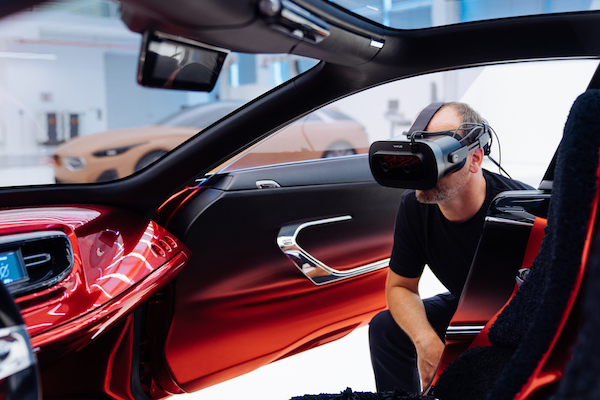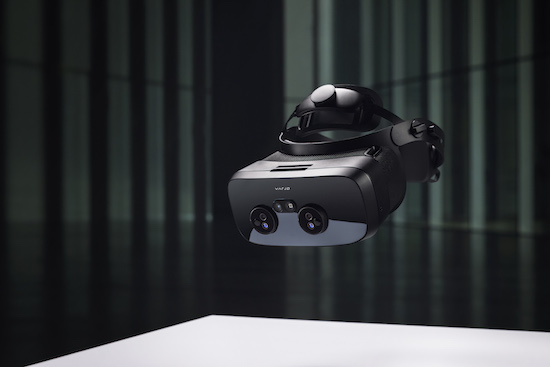A New Way to View and Fix the World
When your experts and technicians cannot travel, AR/VR applications could be their eyes and ears.

Thomas Unterluggauer, Creative Manager CGI, KIA Design Center Europe, using Varjo’s XR device to perform automotive design review. Image courtesy of Varjo.
Engineering Resource Center News
Engineering Resource Center Resources


Dell

Latest News
April 10, 2021
During the height of the COVID shutdown last year, the use of remote experts—virtual expert visits enabled by AR/VR technologies—emerged as a solution to address the shortage of technical experts due to travel restrictions. In a March 2020 report titled “Transforming Frontline Operations with Augmented Reality Technology,” the research firm LNS wrote, “AR enables a variety of high-value use cases such as remote expert access, digital work instructions, and in-context training that not only contribute to operational performance improvement, but also directly help to address the workforce skills gap challenges that threaten to hold back manufacturing and other industrial sectors” (made available through PTC, www.ptc.com).
Remote Viewing
Epson, a household name in the printer business, has also entered the AR/VR market. In 2019, it launched the Epson Moverio smart glasses with the AR software Moverio Assist. The company probably didn’t anticipate how the package might find new uses during the pandemic a year later.
Targeting the field technicians, the company wrote, “by ‘seeing what the field technician sees’ in real-time, remote experts can provide the appropriate audio or text instructions, PDF service manuals or tutorial video links to help expedite repairs.”
AR-powered applications like Moverio Assist let the expert remotely guide a field technician with real-time instructions and advice, allowing them to render services without travel. The use case is particularly helpful for engineering and manufacturing, where repair and assembly operations often involve intimidating knowledge of the assemblies and access to 3D CAD documents.
Lightweight 3D model viewers, a regular feature of Product Data Management (PDM) and Product Lifecycle Management (PLM) solutions, are also gradually moving toward AR/VR. In 2019, Terex, a U.S. manufacturer of drilling machines and construction equipment, partnered with the 3D collaboration software developer Vertex to improve collaboration with its customers.
“We’ve given the ability to view and interact with 3D models to a more diverse group of users within our customer base to satisfy their needs for design reviews,” said Ryan Kloos, Sales Application Supervisor, Terex. “By providing more detailed information for customers to review, that minimizes confusion and rework. We’ve found that with Vertex, the customer experience has vastly improved and we can accelerate our cycles.” (For more on this use case, read “Connecting Service to Design” by Randall Newton, November 2020, DE.)
These use cases exemplify how engineering data, maintained as detailed CAD models, are now finding new uses among the frontline technicians with limited exposure to CAD. The use of AR/VR-powered remote applications have been gradually replacing the paper manuals and PDF instructions, but the pandemic appears to have accelerated the shift. The trend is of interest to software developers like PTC, Autodesk, Dassault Systemes, and Siemens, which offers both CAD and PLM products.
Space Viewing
For some field workers in refineries, manufacturing plants, and power plants, a lightweight tablet loaded with animations and annotated 3D models might serve as repair and instruction manuals, but for the crews working on the Orion spacecraft from NASA, a different solution is required.
Mary Lakaszcyck, a technician with ASRC Federal Data Solutions, a subcontractor to Orion manufacturer Lockheed Martin, demonstrates a pair of augmented reality (AR) goggles inside the high bay of the Neil Armstrong Operations and Checkout Building high bay at NASA's Kennedy Space Center in Florida on Jan. 16, 2020.
Image Courtesy: NASA/Cory Huston
Lockheed Martin’s solution to this was Hololens 2 headsets from Microsoft. “They didn’t have to refer back to a computer screen or paper drawings during that entire activity,” said Shelley Peterson, Lockheed Martin Principal Investigator for AR. “Out on the shop floor they can put on the HoloLens 2 device, power it up, and it has all the content that they need to figure out how to do that task overlaid right there on the structure.”

Varjo XR-3, the latest generation AR device from Varjo. Image courtesy of Varjo
Peterson estimated that AR reduced touch labor by 90%. As a result, “We’re now completing 8-hour activities in just 45 minutes,” she added. Hololens 2 is also part of the headgear offered by Trimble XR10, targeting those in the construction industry. Hololens 2 Industrial Edition is priced $4,950.
In automotive and aerospace, AR/VR-based design review and training is gaining ground. Varjo, which counts Kia and Volvo among its customers, recently made public the details of its involvement with Boeing for the Boeing Starliner project, jointly developed by Boeing and NASA.
The spacecraft launch into orbit involves a complex sequence of commands. Part of the astronaut training is practicing these operations in simulation over and over to eliminate potential mechanical and human errors during the real event.
“When the first crewed mission aboard CST-100 Starliner takes place, the crew will have banked hundreds of training hours for each phase of the entire mission—including launching, docking, re-entering the atmosphere and landing phases—using Varjo’s human-eye resolution VR devices.,” the company wrote.
Varjo’s latest generation hardware XR3 and VR3 requires NVIDIA RTX GPUs to run. For software developing interactive VR content, Dell offers VR-ready workstations in its Dell Precision product line featuring NVIDIA RTX GPUs. VR-ready products are configured to ensure optimal VR experience with low latency, high refresh rate, and high memory to accommodate real-time interaction with large models.

Epson offers smart glasses with Moverio Assist software to enable remote expert dispatch. Image courtesy of Epson.
According to the researcher LNS, “Research shows that organizations that are Industrial Transformation (IX) Leaders are more likely to implement a variety of Connected Worker technologies than IX Followers, including AR and other digital technologies that are closely related and often part of an AR solution.”
More Dell Coverage

More NVIDIA Coverage
Subscribe to our FREE magazine, FREE email newsletters or both!
Latest News





